Recently the FCC (Federal Communications Commission), the US regulatory body, approved the use of 1200 MHz in the 6 GHz band for unlicensed use. This represents a major shake-up for the WiFi industry and will possibly enable other technologies to use this portion of the spectrum as well.
While the FCC only has regulatory jurisdiction in the United States, it has great influence internationally and on the decision-making of many manufacturers. This comes after the WiFi Alliance (made up of different manufacturers) reconfirmed in January its intention to promote the use of the 6 GHz band by defining a new name for devices that support WiFi 6 in the 6 GHz band, under the name WiFi 6E. So far, the FCC is the first regulator to incorporate this band.
To understand what this means and why it comes as surprising news to those of us who follow technological evolution closely, we will briefly review some technical points of WiFi technology in its different versions.
Standards, bands and channels
The standardisation of WiFi is established in the different IEEE 802.11 standards. The first standards, 802.11b/g, use the unlicensed 2.4 GHz band, while in more recent standards there is a tendency to work in other bands with lower usage and higher spectral availability. The best known of these is the 5 GHz band.
The 2.4 GHz band, in addition to having little spectrum availability, has a rather particular channelisation (to coexist with other technologies such as Bluetooth) that generates many problems in practice. That is, although there are 13 (or 14) channels in this band, only 3 (or 4) channels can be used without overlapping.

Recommended practice is to use only channels 1, 6, 11 (and 14), but if there is a nearby system with good signal level configured on channel 3, it will generate interference to systems configured on both channel 1 and channel 6.
The 5 GHz band has a greater availability of channels, which may vary from country to country, and allows a greater aggregation of 20 MHz channels compared to the 2.4 GHz band. The following table shows the channelisation.
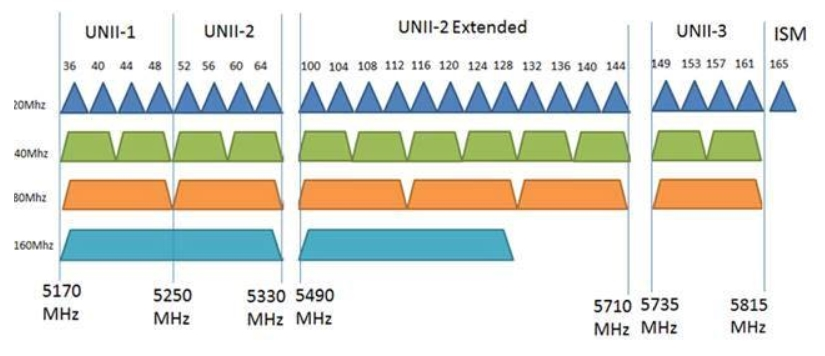
There is a clear movement of the new standards to other bands with lower utilisation than the 2.4 GHz band. The 802.11n standard is intended to be implemented in both 2.4 GHz and 5 GHz, while 802.11ac is only standardised for use in the 5 GHz band.
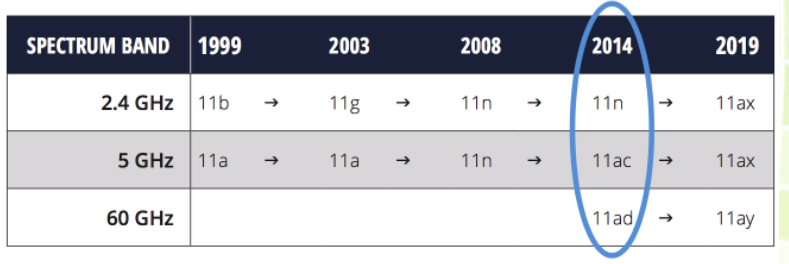
The new 802.11ax standard, also known as WiFi 6, uses both the 2.4 GHz and 5 GHz bands.
One can also mention the case of 802.11ad using the 60 GHz band or the case of 802.11ah in the 915 MHz ISM band (the latter band is used extensively by other technologies).
The following table clearly shows the spectrum availability for different standards measured in MHz. It is clear that the 5 GHz band has a huge advantage over the 2.4 GHz band in terms of number of channels. Of course the propagation conditions of higher bands are more limited, but for capacity planning the 5 GHz band is always a good choice.
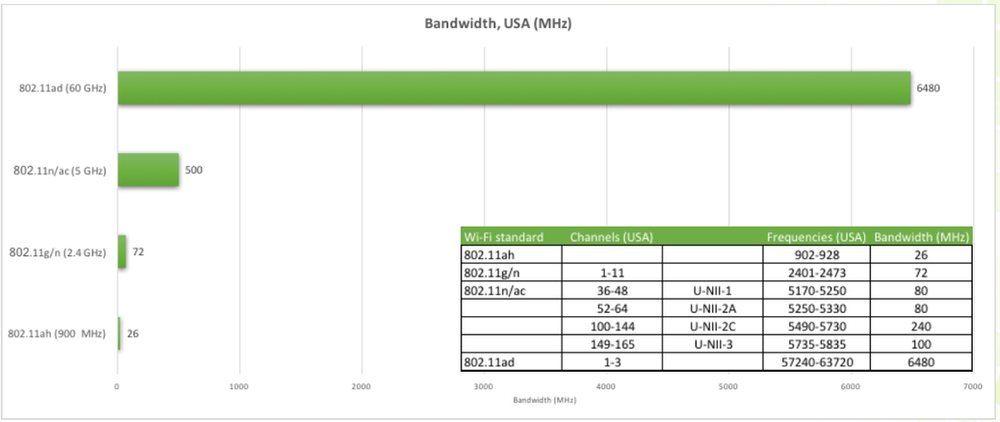
What contributions does WiFi 6 make?
Before we get to WiFi 6E, let's talk briefly about WiFi 6. It should be noted that the WiFi Alliance recently started calling 802.11ax standard WiFi 6, 802.11ac WiFi 5 and 802.11n WiFi 4 in order to make it easier for users to identify the different generations. This change is relatively recent and commercial products are slowly beginning to be identified by this nomenclature.
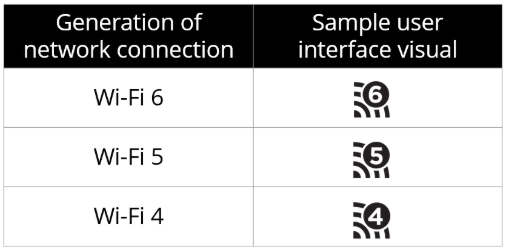
WiFi 6 takes many principles from 802.11ac and incorporates some substantial changes to 802.11ac. The following is a brief description of the main new features of WiFi 6:
Orthogonal frequency division multiple access (OFDMA): In previous standards the modulation scheme and waveform used is OFDM, while the medium access scheme follows the CSMA/CA mechanism that senses the medium and in case it is busy waits for a random time within a range that grows as the channel remains busy.
This backoff mechanism has some drawbacks when low latency applications are required and is one of the main reasons why WiFi does not scale in the number of simultaneously connected users (number of associations of an Access Point). Therefore, in the new WiFi 6 standard, OFDMA is introduced as a way of coordinating access to the medium by dividing time and frequency resources and assigning different users different resources, thus improving latency in both uplink and downlink, achieving greater efficiency and performance in high-density environments.
Multi-user multiple input multiple output (MU-MIMO): by using this technique it is possible to send data to different users at the same time and on the same frequency resource by means of what is known as spatial multiplexing as long as the SNR (Signal Noise Ratio) is high and there is low correlation between the data. This is a further step towards achieving higher throughput by significantly improving spectral efficiency.
160 MHz channels: increase the channel width in order to increase the bandwidth and achieve low latencies. This channel width shall only be used in case of good SNR levels.
Target wake time (TWT): this functionality allows the AP and associated devices to coordinate when and how often they will communicate and is mainly intended for IoT devices where very low consumption is required. At the same time, the AP is aware of when the device will require resources, thus facilitating the task of allocating resources at the media access level and improving spectral efficiency.
1024-QAM: in search of higher spectral efficiency, a higher modulation level is introduced, which can logically be used as long as the SNR level allows it.
Transmit beamforming: with this technique it is possible to concentrate the power radiation towards the target point (the user), thus achieving a higher signal strength to the user given a power budget in the transmitter and at the same time avoiding interference to other users, which significantly improves the SNR of the system.
So what is WiFi 6E?
WiFi 6E is nothing more than the implementation of the WiFi 6 standard (802.11ax) on the 6 GHz band. Those of us who have been following the evolution of the standards are surprised to see the introduction of the 6 GHz band since, until now, the predominant bands for WiFi family standards were 2.4 GHz, 5 GHz and to a much lesser extent 60G Hz or 915 MHz.
The 5 GHz band goes up to 5.925 GHz. With WiFi 6E it is extended by a further 1200 MHz, i.e. up to 7.125 GHz, which adds about 14 80 MHz channels or 7 160 MHz channels. Given the slightly higher frequency, the range can be expected to be 10-20% lower compared to the 5 GHz channels.
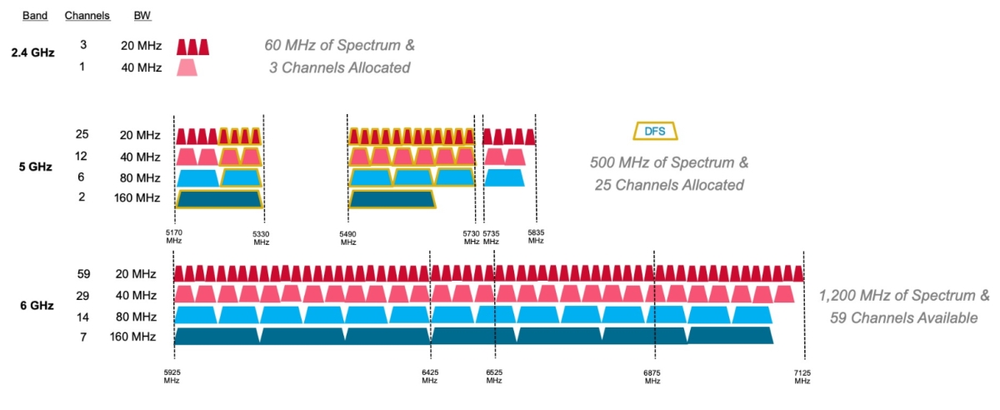
What's in the 6GHz band today?
Many operators use different bands (established by the ITU) for point-to-point microwave links. The 6 GHz band is precisely one of the bands used for this purpose, as set out in recommendations F.383-9 and F.384. In this portion of the spectrum, satellite links (fixed-satellite service) are also found in many countries in the so-called C-band.
If the WiFi market moves in this direction (nothing indicates otherwise), then 6 GHz radio links will have to coexist with WiFi 6E and other standards that may emerge in the unlicensed 6 GHz band.
What about the manufacturers?
Many products supporting WiFi 6 have already been available for some time. However, the development of WiFi 6E is at a much earlier stage, which is logical because so far there has been no clear market. With the FCC ruling, and perhaps soon the European regulation, it is to be expected that the development will progress in this direction.
Broadcom, one of the leading US chipset manufacturers along with Qualcomm, announced in February what would be the first chipset to support WiFi 6E. This is the BCM4389 which, in addition to 6 GHz band support, also supports 2.4 GHz and 5 GHz. So far, it is the only chipset that supports WiFi 6E and there are no user devices (APs, smartphones) that support it.
Conclusions
The WiFi family of standards has become one of the main points of connection to the internet for users along with mobile networks. The quest for higher speed and lower latency brings with it implementations that improve signal processing, increasing spectral efficiency and inevitably, at the same time, have a need for more spectrum. This spectrum is most easily found in the higher bands, which today have other uses and also have less coverage. This accompanies the trend towards capacity planning and access points with smaller coverage.
WiFi 6 includes many technical innovations, some of which are already present in mobile networks. WiFi 6E promises to be an interesting alternative to apply this technology in a spectrum region with a larger number of channels. We will have to wait until the market for both APs and mobile devices develops and supports this new band.
By:
Mauricio Gonzalez Nappa, Product Line Specialist Telco & Smart Cities.
Mauricio is an electrical engineer (Telecommunications) and holds a master's degree in Mobile Networks and Telecommunications. In addition to his work at Isbel, he teaches Antennas and Propagation and Multimedia over IP courses at the Faculty of Engineering of the University of the Republic.
Sources:
https://www.wi-fi.org/discover-wi-fi/wi-fi-certified-6
https://www.wi-fi.org/beacon/the-beacon/wi-fi-certified-6-gains-momentum
https://www.theverge.com/2020/4/23/21231623/6ghz-wifi-6e-explained-speed-availability-fcc-approval
https://www.semfionetworks.com/blog/mcs-table-updated-with-80211ax-data-rates
https://www.broadcom.com/company/news/product-releases/52926



